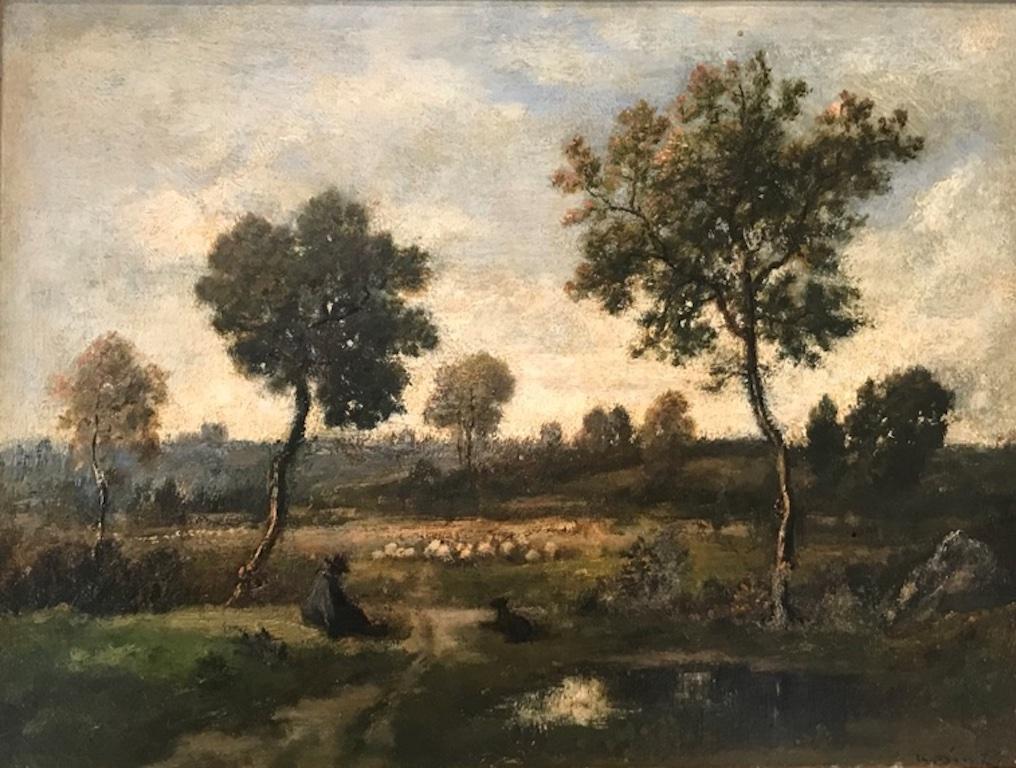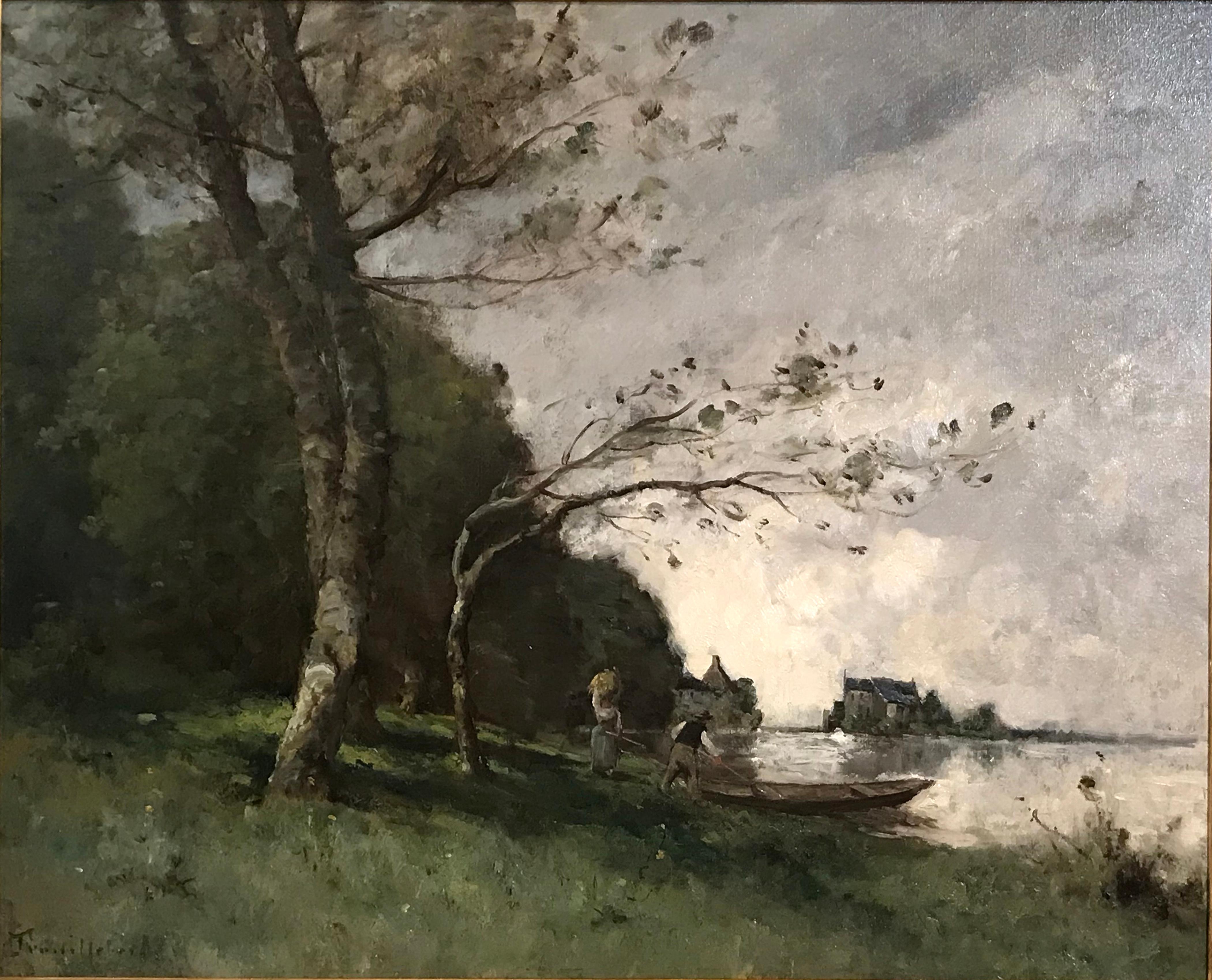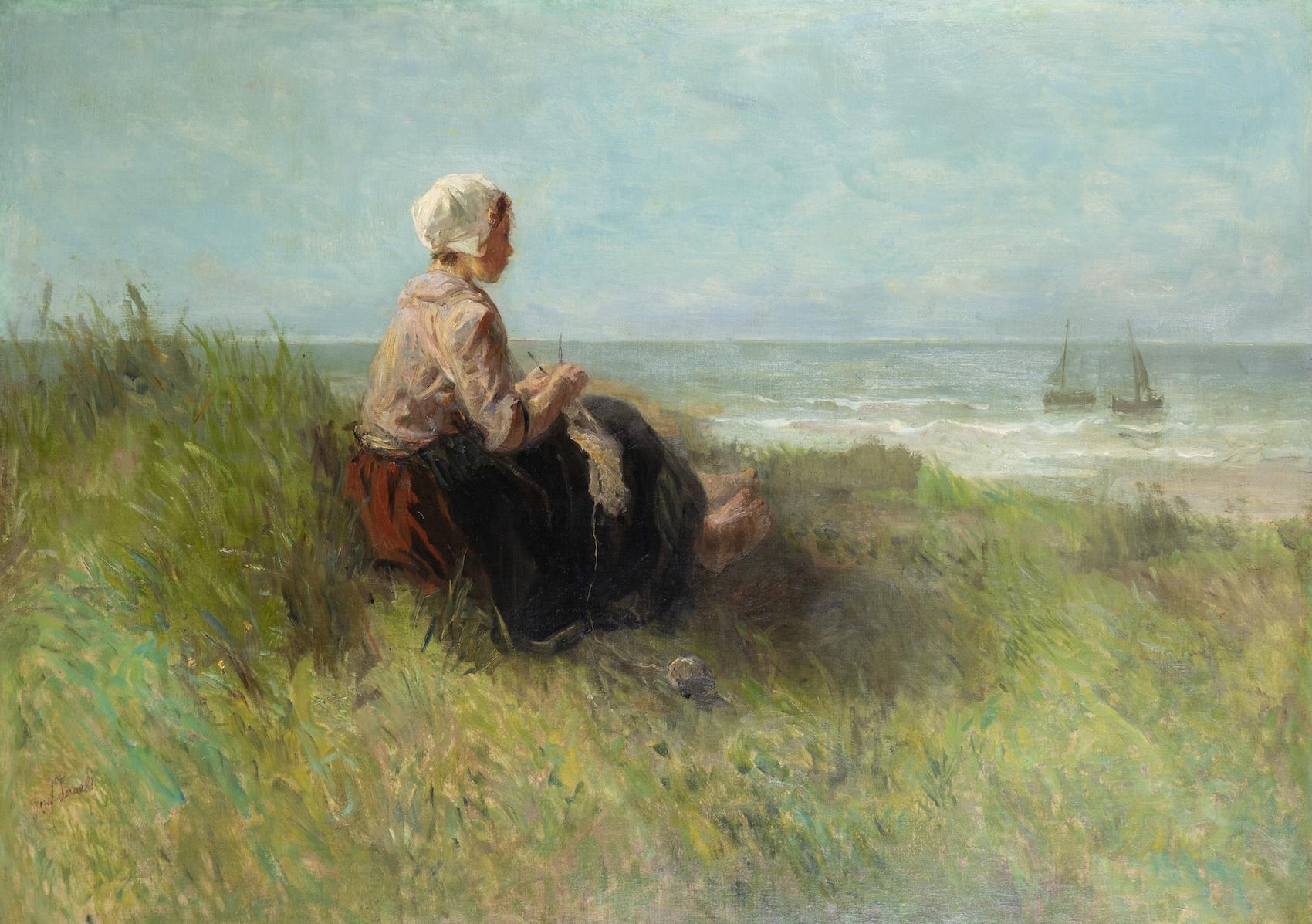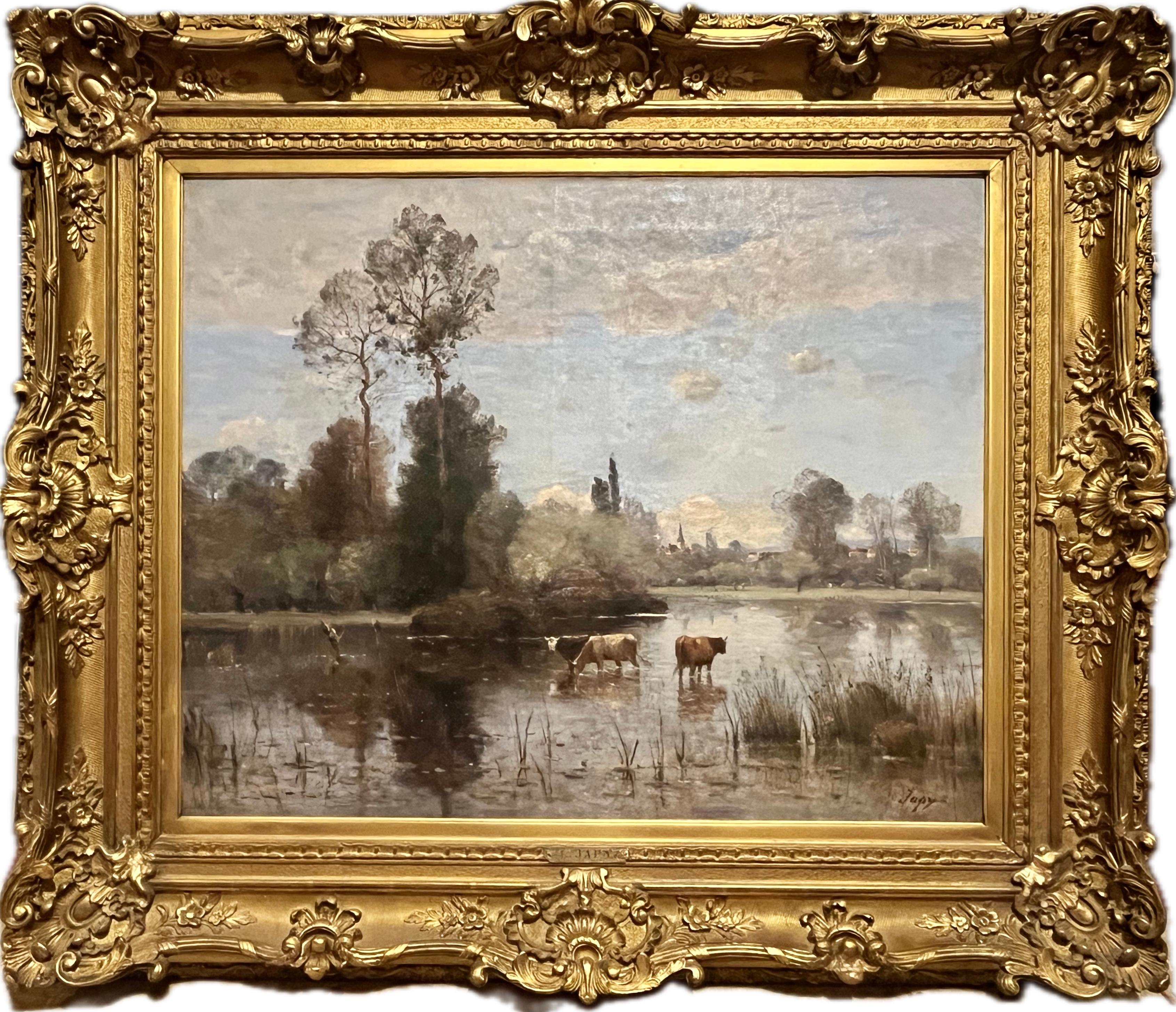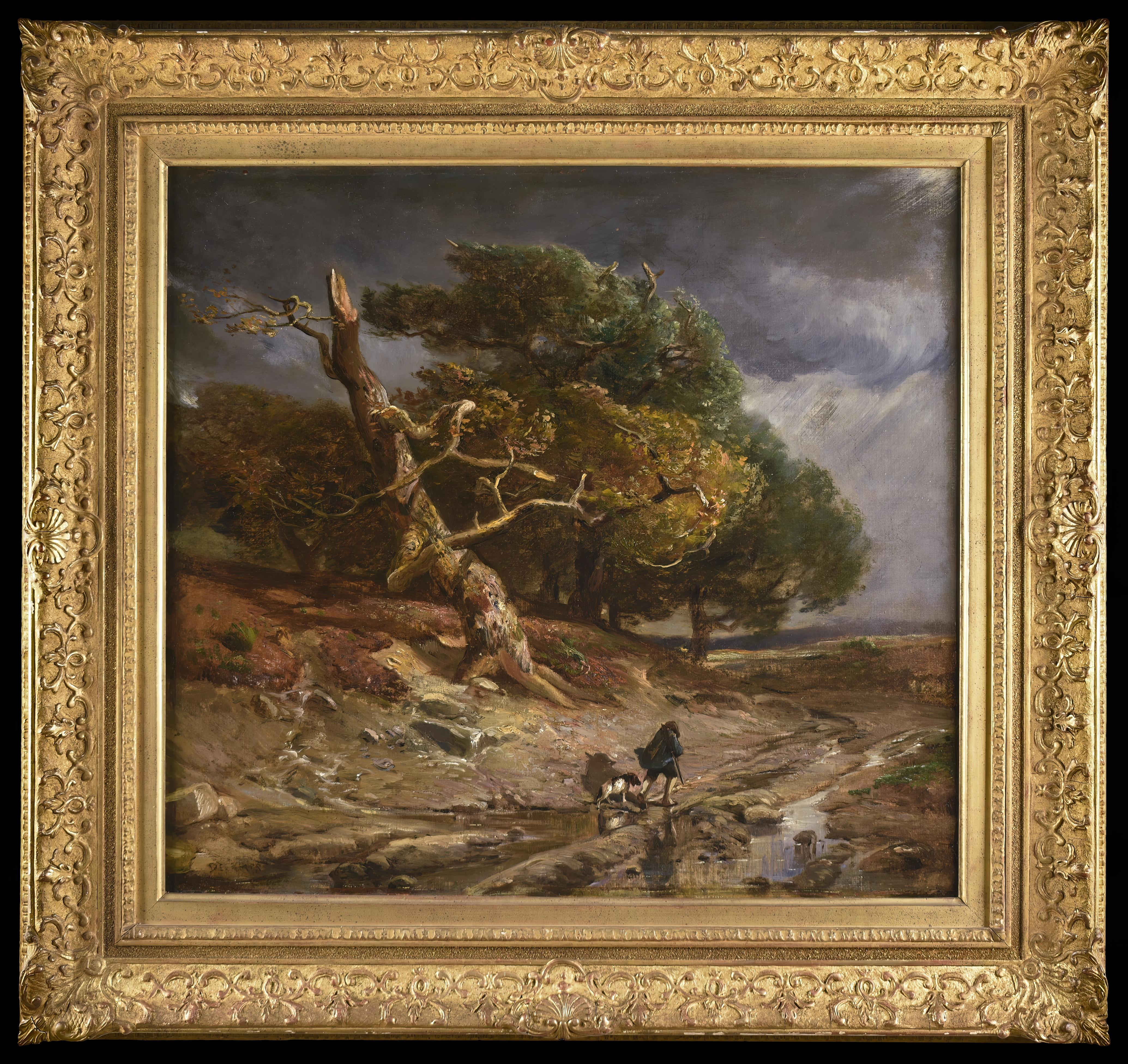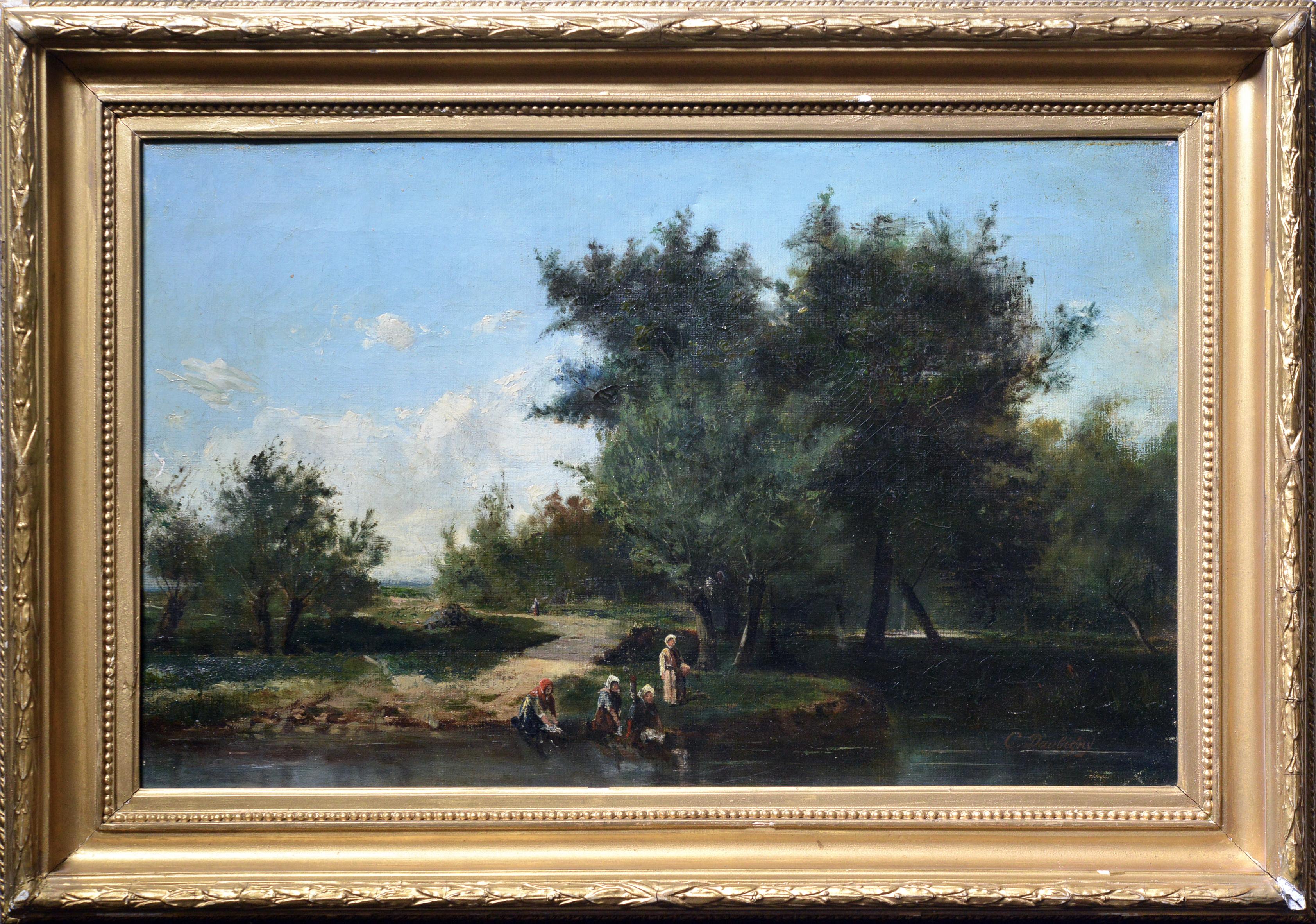Charles Henry Miller"Flushing Landscape with Cows, " Charles Henry Miller, Barbizon, Rural Farmcirca 1880
circa 1880
About the Item
- Creator:Charles Henry Miller (1842-1922, American)
- Creation Year:circa 1880
- Dimensions:Height: 17.5 in (44.45 cm)Width: 23.25 in (59.06 cm)
- Medium:
- Movement & Style:
- Period:
- Condition:
- Gallery Location:New York, NY
- Reference Number:1stDibs: LU1841211574592
Charles Henry Miller
Charles Henry Miller was a noted artist and painter of landscapes from Long Island, New York. The American poet Bayard Taylor called him, "The artistic discoverer of the little continent of Long Island." Miller was educated at Mount Washington Collegiate Institute and graduated in medicine at the New York Homeopathic Institute in 1864. Before his graduation, Miller had occasionally painted pictures and in 1860, he exhibited The Challenge Accepted at the National Academy of Design, in New York City. Miller lived in Queens at the summer estate, Queenslawn, originally purchased by his parents. Miller went abroad in 1864 and again in 1867 and was a pupil in the Bavarian Royal Academy in Munich under the instruction of Adolf Lier. After the 1874 death of his father, Jacob Miller, who was a wealthy architect and builder, Miller received a large inheritance that allowed him to paint as an independent artist for the remainder of his long life. Miller worked seriously and exhibited regularly, including at international exhibitions. The majority of his oil paintings depict Long Island subjects, especially those in and around Queens Village. Fed up with the development of the eastern part of Queens (present-day Nassau County), Miller began to spend part of his summers in East Marion, Long Island, c. 1910. Here Miller spent his time sketching and painting the surrounding areas. In 1885, Miller published The Philosophy of Art in America, using the pseudonym Carl De Muldor (he was descended from the De Muldor family). His work was recognized: in 1873, Miller was elected an associate of the National Academy of Design and an academician in 1875. Miller served as president of the New York Art Club in 1879 and of the American Committee at the Munich International Exposition in 1883.
- ShippingRetrieving quote...Ships From: Larchmont, NY
- Return PolicyA return for this item may be initiated within 3 days of delivery.
- "Canal Pinelli, Venise" Paul Désiré Trouillebert, Venetian Scene in ItalyBy Paul Desire TrouillebertLocated in New York, NYPaul Désiré Trouillebert Canal Pinelli, Venise Signed lower left Oil on canvas 18 3/4 x 12 3/8 inches Provenance: Artist's studio sale, 1887, no. 4 With M. Newmann London Sale, Christie's, London, Save the Children Fund, May 16, 1961 (according to an inscription on the reverse) Private Collection, United Kingdom Literature: Marumo et al, Paul Désiré Trouillebert: Catalogue Raisonné de l'œuvre peint, Stuttgart, 2004, cat. no. 0362 p. 336, illustrated. Paul Désiré Trouillebert was born in Paris in 1829 and died in the city June 28, 1900. He is considered a portrait, genre and landscape painter from the French Barbizon School. He was a student of Ernest Hébert [1817-1908] and Charles-François Jalabert [1819-1901], and made his debut at the Salon of 1865, exhibiting a portrait. At the Paris Salon of 1869, Trouillebert exhibited “Au bois Rossignolet”, which was a lyrical Fontainebleau landscape that received great critical acclaim. Trouillebert concentrated on portraits until about 1881, when he began to focus on atmospheric silvery landscapes steeping in cool damp color. In 1882, he exhibited a large landscape titled “Baignneuses” which was well received and helped him gain a reputation as a landscape painter. Another noted work was commissioned by Edmé Piot, a public works contractor. The painting, “Travaux de relèvement du chemin de fer de ceinture: le pont du Cours de Vincennes” (Cleveland Museum) was of a railway project initiated in 1851, after Napoleon III came to power. The commission included four related views of the Paris railway construction, which was completed in February 1889. After the 1860’s, the misty Barbizon landscapes by Jean-Baptist- Camille Corot’s [1796-1875] had become astonishingly vogue, which brought about a trove of imitators. His followers and students; Henri Joseph Constant Dutilleux [1807-1865], George Devillers, Achille François Oudinot [1820-1901], Edouard Brandon [1831-1887] and Trouillebert were not trying to mislead the public, he was their idol. However, the greatest confusion has always been over works by Corot and Trouillebert because both artists painted river landscapes at dawn or dusk with a very similar approach, palette and style. Like Corot, Trouillebert painted a wide variety of subjects, including genre scenes, portraits and nudes. Trouillebert would receive the most attention as a result of an 1883 court case involving one of his paintings. The painting “La Fontaine des Gabourets” had been sold by one of Paris’ more prominent dealers George Petit to writer Alexandre Dumas fils. Trouillebert’s signature and been removed and resigned Corot. The fake was discovered by Robaut and Bernheim-Jeune and returned to the original seller, Tedesco. Trouillebert, who had nothing to do with the fraud, brought legal action against the guilty parties to regain his reputation and clear his name. The trial made all of the papers and Trouillebert won his case. George Pettit...Category
19th Century Landscape Paintings
MaterialsCanvas, Oil
- "North Conway Farm, " Edward Hill, White Mountain School Antique Landscape ViewBy Edward HillLocated in New York, NYEdward Hill (1843 - 1923) Haying at a North Conway Farm with Mount Washington in the Distance, New Hampshire Oil on canvas 13 1/2 x 20 1/2 inches Signed lower right Provenance: Private Collection, Dallas, Texas Born in Wolverhampton, England in 1843, Edward Hill was the ninth of ten children. Though ultimately less well known than his older brother Thomas Hill (1829-1908), Edward was a productive painter in oil and watercolor for more than sixty years, producing images of the White Mountains of New Hampshire, southern genre scenes, still-life paintings, portraits, American Indian pictures...Category
Late 19th Century Hudson River School Landscape Paintings
MaterialsCanvas, Oil
- "Tree, Trunk, and Roots, New York" Joseph Stella, American ModernismBy Joseph StellaLocated in New York, NYJoseph Stella (1877 - 1946) Tree, Trunk, and Roots, Bronx, New York, circa 1924 Oil on canvas 12 x 16 inches inscribed in another hand Joseph Stella/Estate and bears Joseph Stella Estate stamp (on the reverse) Provenance: The Estate of the Artist Rabin & Kreuger, New Jersey Parke Bernet Galleries, New York, March 14, 1968, Lot 147 ACA Galleries, New York Thence by descent Stella was born June 13, 1877 at Muro Lucano, Italy, a mountain village not far from Naples. He became painter laureate of Muro Lucano when he was in his teens with a representation of the local saint in the village church. Stella immigrated to America in 1896 and studied medicine and pharmacology, but upon the advice of artist friend Carlo de Fornaro, who recognized his undeveloped talent, he enrolled at the Art Students League in 1897. Stella objected to the rule forbidding the painting of flowers, an indication of his lifelong devotion to flower painting. He also studied under William Merritt Chase in the New York School of Art and at Shinnecock Hills, Long Island in 1901-1902, displaying the bravura brushwork and dark Impressionist influence of Chase. Stella liked to paint the raw street life of immigrant society, rendering this element more emotionally than the city realists, the Aschcan School headed by Robert Henri. Stella went through a progression of styles--from realism to abstraction--mixing media and painting simultaneously in different manners, reviving styles and subjects years later. The "Survey" sent Stella to illustrate the mining disaster of 1907 in Monongah, West Virginia, and in 1908 commissioned him to execute drawings of the Pittsburgh industrial scene. Steel and electricity became a major experience in shaping his responses to the modern world, and Stella succeeded in portraying the pathos of the steelworkers and the Pittsburgh landscape. Stella went abroad in 1909 at the age of thirty-two, lonely for his native land. He returned to Italy, traveling to Venice, Florence and Rome. He took up the glazing technique of the old Venetian masters to get warmth, transparency, and depth of color. One of Stella's paintings was shown in the International Exhibition in Rome in 1910 and was acquired by the city of Rome. The influence of the French Modernists awakened his dormant individuality. His friendship with Antonio Mancini, a Futurist, also played a role in his new style. At the urging of Walter Pach...Category
1920s American Modern Landscape Paintings
MaterialsCanvas, Oil
- "Mount Rockwell, Glacier National Park, Montana, " Mountain Lake Landscape ViewBy Charles Warren EatonLocated in New York, NYCharles Warren Eaton (1857 – 1937) The Shadow of Mount Rockwell, Glacier National Park, Montana, 1921 Oil on canvas 20 x 24 inches Signed lower right: CHAS WARREN EATON. Provenance: The artist The Macbeth Gallery, New York Private Collection Sotheby's New York, American Art, April 14, 1989 ConocoPhillips, Houston Simpson Galleries, Houston, Fine Art & Antiques, May 18, 2019, Lot 447 Exhibited: New York, The Macbeth Gallery, Paintings of Glacier National Park by Charles Warren Eaton, December 13, 1921 - January 2, 1922, no. 2. Literature: "Two Exhibitions at Macbeth's," American Art News, New York, Vol. XX, No. 10, December 17, 1921. A contemporary critic wrote that the paintings of Charles Warren Eaton appeal to “the dreamers who find in them the undiscovered scenes in which their fancy long has dwelt.” Eaton’s contemplative landscapes exude a spiritual quality that moves the observer into a similar frame of mind. He loved to depict the ethereal light of dawn and dusk in late autumn or winter, usually without any reference to human or animal figures or buildings. These Tonalist paintings, with their subdued palette and relatively intimate scale, marked a definite break with the fading popularity of the panoramic and romantic views of the Hudson River School painters. Charles Warren Eaton was born in Albany, New York to a family of limited means. He began painting while working in a dry-goods store. At age 22, he enrolled at the National Academy of Design in New York City and then studied figure painting at the Art Students League. By 1886, he was successful enough to quit his day job and make a living as a landscape painter. That year, he traveled to Europe with fellow Tonalist painters Leonard Ochtman and Ben Foster. In France, Eaton visited popular artist’s spots such as Paris, Fontainebleau and Grez-sur-Loing, and fell in love with the loose brushwork and moody style of French Barbizon painting. Returning to the United States, Eaton fell under the spell of George Inness, the foremost exponent of Barbizon style in the United States. In 1888, Eaton settled near Inness in Bloomfield, New Jersey, where Eaton lived until his death in 1937. In this period, he painted shadowy and ambiguous landscapes inspired by rural scenery in the northeastern United States. His signature theme was a cropped view of the branches, trunks, and foliage of a pine grove silhouetted against a delicately illuminated sunset or moonlit sky. He painted this vision so often between 1900 and 1910 that he picked up the sobriquet ‘‘The Pine Tree Painter.” After 1910, Eaton responded to the popularity of Impressionism by using brighter colors and painting sunlit daytime scenes. In 1921, he was hired to paint Glacier Lake, in Glacier National Park by the Great Northern Railroad Company as part of their ‘See America First’ campaign. He produced more than 20 paintings, among the artist's last works, that now poignantly remind viewers of the vast disappearing glaciers. Eaton tended to approach this mountain scenery from an oblique vantage point; he liked to capture small episodes, showing mountaintops nearly obscured by dramatically attenuated screens of fir trees. Eaton, like many Tonalist artists of his generation such as Henry Ward Ranger, John Francis Murphy, and Charles Melville Dewey...Category
1920s Tonalist Landscape Paintings
MaterialsCanvas, Paint, Oil
- "The Green Parasol, " Henry Hannig, American Impressionist, Woman in Beach SceneBy Henry HannigLocated in New York, NYHenry Charles Hannig (1883 - 1948) The Green Parasol Oil on canvas mounted on board 6 x 7 3/4 inches Provenance: R.H. Love Galleries, Chicago, Illinois Private Collection, Lake Orion, Michigan Hannig, born in Hirschberg, Germany on 27 February 1883, came to America with his parents at the age of seven. He attended school in the southwest suburbs before the family settled in Chicago. Young Henry enrolled in the Chicago Academy of Fine Arts where Lawton Parker became his mentor. He made ends meet by working in industrial design and illustration. By 1908 he was a pupil in the School of the Art Institute of Chicago where students followed the traditional European drawing curriculum, beginning with the copying of master engravings and drawing after plaster casts, then concentrating on the nude figure. Students worked toward the goal of winning various academic prizes. One of Hannig's fellow students was Louis Ritman...Category
1910s American Impressionist Figurative Paintings
MaterialsCanvas, Oil, Board
- "Off Route #5, Guilford, Vermont" Wolf Kahn, New England Landscape with BarnBy Wolf KahnLocated in New York, NYWolf Kahn Off Route #5, Guilford, Vermont, 1975 Signed lower right; dated and inscribed "#63" on the reverse Oil on canvas 24 x 34 inches An important member of the second generatio...Category
1970s Landscape Paintings
MaterialsOil, Canvas
- Troupeau de moutons dans la clairièreBy Narcisse Virgilio Díaz de la PeñaLocated in Barbizon, FROil on canvas 24.5 x 32.5 cm, signed lower right Provenance: Sale Galerie Boussod-Valadon & Allard, Paris, 03/03/1919, Georges Petit Hotel Drouot Ferri Sale 05/06/2019 lot no 18 L...Category
19th Century Barbizon School Landscape Paintings
MaterialsCanvas, Oil
- Moulin sur la vienne , oil on canvas , signed lower leftBy Paul Desire TrouillebertLocated in Barbizon, FR“Moulin sur la Vienne” Oil on canvas 65.5 x 81.5 cm. Signed lower left Provenance: collection of Monsieur and Madame Baudet, friends of the painter. Exhibition: Salon d'Hiver 1910, ...Category
Late 19th Century Barbizon School Landscape Paintings
MaterialsOil, Canvas
- Waiting by Jozef Israëls - Landscape oil paintingBy Jozef IsraëlsLocated in London, GBWaiting by Jozef Israëls (1824-1911) Oil on canvas 95.3 x 133.9 cm (37 ½ x 52 ¾ inches) Signed lower left, Jozef Israels A monumental painting by one of...Category
19th Century Barbizon School Figurative Paintings
MaterialsCanvas, Oil
- Louis Aime JapyBy Louis Aimé JapyLocated in Dallas, TXLouis Aimé Japy (1840-1916) Oil on canvas Cows in river with village in background Signed lower right, Japy. Canvas 26” x 32” Overall in a period gilt frame 38” x 44”. Conditi...Category
1870s Barbizon School Landscape Paintings
MaterialsCotton Canvas, Oil
- Barbizon landscape with a man and his dog walking through the stormBy Alexandre-Gabriel DecampsLocated in Brooklyn, NYAlexandre-Gabriel Decamps (March 3, 1803 – August 22, 1860) was a French painter and lithographer known for his contributions to the Orientalist movement and his distinctive style th...Category
Mid-19th Century Barbizon School Landscape Paintings
MaterialsCanvas, Oil
- Laundresses on River 19th century Barbizonian Landscape by French MasterLocated in Stockholm, SESigned lower right "C. Daubigny". As we gaze upon the painting, we are immediately drawn to the foreground, where a small group of women are diligently washing clothes on the banks o...Category
Mid-19th Century Barbizon School Landscape Paintings
MaterialsCanvas, Wood, Cotton Canvas, Oil
